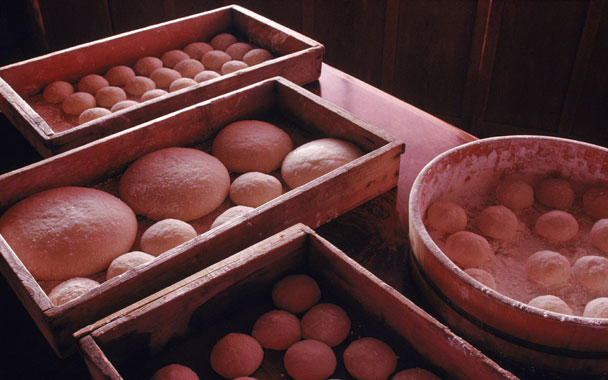When I buy packaged Japanese foods such as soups, noodles or mentaiko sauce for pasta, the labels are always written in Japanese, save for a Nutrition Facts sticker. I speak just enough Japanese to get by at an izakaya and can’t read it at all, so I usually rely on a series of simple pictographs for cooking directions. If such graphics are lacking, I assume the food is ready to eat without further preparation.
All this explains why on New Year’s Day I found it perfectly normal to chow down on an okagamimochi, or mirror rice cake, right out of the package. These two-tiered affairs consisting of a small disk of glutinous rice cake atop a larger one are a Japanese New Year decoration and are often quite elaborate. In bygone days in Japan all the people on one street would participate in mochitsuki, or mochi pounding, at the end of the year. Steamed glutinous rice is vigorously pounded with a mallet until it achieves an even stickier consistency. It’s then cut into pieces or shaped into disks.
These days some people use automatic mochi pounding machines at home, and the cakes are also mass-produced for sale in supermarkets. Mine was of the latter variety and was much smaller and decidedly less gussied up than the traditional kind. Having seen Tampopo’s infamous mochi-choking scene I had a glass of water at the ready. After smashing the top of the plastic packaging, I popped the white mass out, broke off a bit, and began chewing. It resembled a hard-boiled egg that had been cracked, and it wasn’t gooey at all. Even so, the water came in handy as my mochi was quite dry, which led me to question its freshness.
Scratching my head in wonder as I looked at the March 31 expiration date, I phoned my friend Willyum, my go-to guy when it comes to Japanese cuisine. As I told him of my mochi misadventure and he relayed it to his Japanese wife, Naomi, I could hear her laughing in the background. Willyum told me I should have grilled or boiled the mochi before attempting to ingest it. The next day he called and invited me over the following Sunday for a mochi-cooking party.
Japanese usually break open their okagamimochi and cook it the second Saturday or Sunday in January in a ceremony called okagamimochi biraki. Although I’m told that these days many treat the gigantic two-tier holiday decoration just like a Christmas tree and simply chuck it after the holiday. As my friends fired up their tabletop grill Naomi said that when she was growing up in Japan they used to pound mochi in her neighborhood, but remarked that these days few people make, much less eat, the rice cakes anymore.
It didn’t take long at all for the hard white blocks to start browning and morph into gelatinous blobs. Some of these were given a quick soak in boiling water and then rolled in a mixture of soy flour and sugar, becoming kinakomochi. Others went straight from the grill to be dipped in oroshi and shoyu, or grated daikon with a little soy sauce, becoming oroshimochi. The third entry in the mochi trifecta was isobe maki mochi or seaweed-wrapped mochi with a touch of soy sauce. Unlike my mishandled mochi, the texture of the rice cakes was quite sticky.



 Pinterest
Pinterest


